Round The World and other travels
A frequent flyer's collection of trip diaries
This is: Russia & Sweden 2014
Red Square and the Kremlin
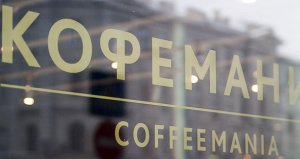 The
wake-up call came, as requested, at 7am precisely: we only had two
full days available in this city and we intended to make the most of
it. Coffeemania, practically next-door to the hotel, turned out to
be a pleasant breakfast stop - pleasant, but eye-wateringly
expensive. Our friendly waiter, unlike most Russians that we had so
far encountered, actually knew how to smile. For the most part his
English was good, but not consistently so, as demonstrated when he
presented me with a glass of bright orange liquid: "... and your
apple juice, Sir." We each had a cappuccino, a freshly squeezed
fruit juice and a blini with smoked salmon and cream cheese,
resulting in a total bill of approximately GBP40 - yikes! After a
brief return to our room, and a chance to reassess the amount of
money we needed to be carrying around, we were ready to get started
on the day's programme.
The
wake-up call came, as requested, at 7am precisely: we only had two
full days available in this city and we intended to make the most of
it. Coffeemania, practically next-door to the hotel, turned out to
be a pleasant breakfast stop - pleasant, but eye-wateringly
expensive. Our friendly waiter, unlike most Russians that we had so
far encountered, actually knew how to smile. For the most part his
English was good, but not consistently so, as demonstrated when he
presented me with a glass of bright orange liquid: "... and your
apple juice, Sir." We each had a cappuccino, a freshly squeezed
fruit juice and a blini with smoked salmon and cream cheese,
resulting in a total bill of approximately GBP40 - yikes! After a
brief return to our room, and a chance to reassess the amount of
money we needed to be carrying around, we were ready to get started
on the day's programme.
 |
 |
 |
| ABOVE: Getting started - walking down Tverskaya Street | ||
Conditions were reasonably comfortable as we set
out on the initial 2km downhill walk along Tverskaya Street, but it
was clear that for several hours to come, it was only going to be
getting warmer. On leaving Pushkin Square, a screeching whistle
interrupted our chat and indicated that we were being reprimanded
for unintentionally jay-walking: apparently use of the pedestrian
underpass was compulsory at this junction. As would become more and
more apparent as the day progressed, it felt as though there was
always somebody watching you in Moscow. It seemed that old habits
died hard - and people say that the UK is the surveillance society!
We continued past an impressive line-up of international designer-name
shops and in due course reached the foot of Tverskaya Street without
falling foul of any further local regulations - or at least, without
any such infringements being noisily brought to our attention. We
amused ourselves for the rest of the day - perhaps a little
immaturely - by attempting to apply
descriptions to subsequent whistle blasts directed at random
unfortunates around town, in such a way as to reflect the varying
intensities of sound and the implied extent of official outrage. A
half-hearted peep signified a 'minor
misdemeanour', a solid note - particularly if the pitch had a
tendency to rise - marked a 'significant transgression',
while a shrill blast preceded by a series of staccato bursts meant 'OFF TO THE
GULAGS FOR YOU, COMRADE!'
![]()
Entering Red Square
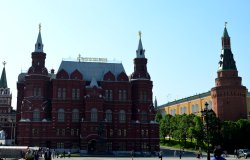 |
| ABOVE: Foot of Tverskaya Street with (l. to r.) gate to Red Square, State Historical Museum and the Kremlin |
At the bottom end of Tverskaya Street we found ourselves staring straight into the sun, shining down on us from behind the otherwise impressive sight of the State Historical Museum, the red brick building dating from the second half of the 19th century that formed the backdrop to many a military parade back in the days of the USSR. We marvelled at the fabulous location of the new Four Seasons hotel, nearing completion on our immediate left. To the right of the State Historical Museum was a corner of the Kremlin, but we knew that this would have to wait until the afternoon.
Our next objective was the impressive structure on the other side of the museum and sandwiched between it and Moscow City Hall: the Resurrection Gate, the entry point to the northwest side of Red Square. Immediately in front of the gate, its green, blue, white and gold colours in sharp contrast to the main structure, was the tiny Iberian Chapel, which interestingly serves as 'kilometre zero' for the Russian road system. The original Resurrection Gate and Iberian Chapel were demolished in 1931 to allow the passage of heavy military vehicles taking part in parades. Both had been reinstated as recently as the mid-90s.
A similar story applied to the low-rise, but colourful and attractive Kazan Cathedral, situated near the opposite end of the State Historical Museum, at the point where Red Square opens out. The original building, dating from 1625, was pulled down in 1936 on Stalin's orders. Reconstructed between 1990 and 1993, it was the first church to be completely rebuilt in post-Communist Russia. As we progressed further into Red Square, the entire left (north-eastern) side was occupied by the GUM store (more of which shortly), while the highlight to our right was Lenin's Mausoleum. As the tomb is closed on Mondays, we knew that we wouldn't be seeing the macabre spectacle on this visit, which at least saved us from all the rigmarole that it reportedly takes to actually get inside.
 |
 |
 |
 |
LEFT and BELOW: The State Historical Museum, Marshal Zhukov statue, Resurrection Gate and the Iberian Chapel, Kazan Cathedral and Lenin's Tomb | |
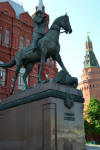 |
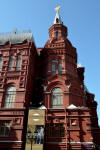 |
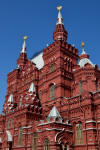 |
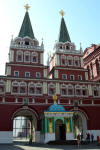 |
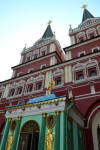 |
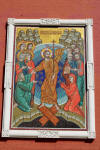 |
GUM
Our next objective, St Basil's Cathedral, was still on 'winter hours'. On the 19th day of May and with the morning temperature on a steady climb through the upper 20s Celsius, whoever devised the attraction's schedule was clearly blessed with an admirable sense of humour. As such, we needed to delay our planned visit to the famous onion-dome huddle and bring forward our call at Moscow's best-known shopping destination. As previously mentioned, the impressive facade of GUM (pronounced goom) occupies an entire side of Red Square. The facility has had an acronym-preserving change of identity in recent times, in much the same manner as the DVD went from being the digital video disc to the digital versatile disc. In GUM's case, what was once the Gosudarstvennyi Universalnyi Magazin (State Department Store) had become the Glavnyi Universalnyi Magazin (Main Department Store).
The building was impressive internally as well as externally, consisting of three long, interlinking arcades on three levels, featuring balconies, bridges and a glass roof reminiscent of a main-line railway terminal in the UK. Its state-run days now over, GUM in the 21st century has more in common with an upscale Western shopping mall, and is home to over 200 separate businesses. A significant part of the ground floor is given over to Gastronom No.1, a nostalgia-provoking supermarket selling everything from basic canned meats reminiscent of the Soviet era, to pricey caviar and champagne.
 |
 |
 |
 |
 |
 |
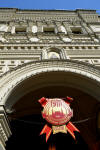 |
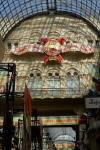 |
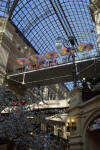 |
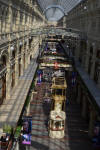 |
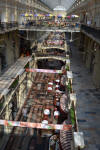 |
 |
 |
St Basil's Cathedral
We returned to St Basil's in good time for its 'winter' opening time of 11am. The former cathedral, officially the Church of the Intercession, was commissioned by Ivan the Terrible, and constructed between 1555 and 1560 on the site of the earlier Trinity Church, where the Holy Fool Vasily (Basil) had been buried in 1552. Basil was an ardent adversary of the tsar, often reprimanding him publicly for his cruel and bloodthirsty ways. He was, however, protected from those ways by his status as Holy Fool, a position considered an emissary of God, so it’s rather ironic that Ivan’s masterpiece is now known by the name of his greatest challenger. The building was confiscated from the Russian Orthodox Church in 1929 and has never been returned. Its unique design has been described as "a structure devoid of restraint and reason" and is thought by some to represent a fire.
In due course we were able to pay our entry fee and begin our self-guided tour. One advantage of the building's status as a former church was that photography was permitted. The elderly ticket collector seemed to be stuck in some kind of loop, smiling widely and repeating ad infinitum: "Welcome! Welcome! No flash!" I was astonished by the maze-like character of the interior, where there was no open space of any significant size at all. It was all very different from the typical western idea of a church interior. As we explored the various chapels and chambers, we heard the first haunting sounds of Orthodox chant, in this case almost certainly piped. It would be a sound that turned up again and again during our time in Russia.
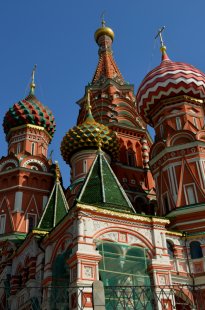 |
 |
 |
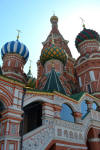 |
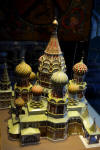 |
 |
 |
|||
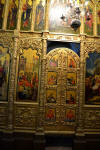 |
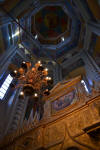 |
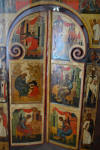 |
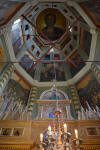 |
Bolshoi Theatre
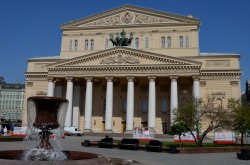
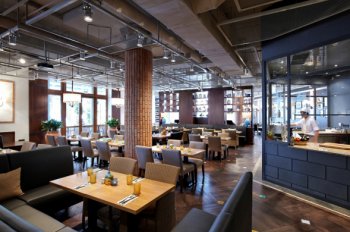 In
many ways, the entire schedule for our first full day in Moscow had
been designed around a visit to the historic Bolshoi Theatre, home
of Russian ballet and opera. There was but one English tour per day
and it started at 12 noon. We made our way to Theatre Square and
waited patiently in line for a while in the now-blazing midday sun.
(Mad dogs, Englishmen and Scotsmen!) But it wasn't to be: in due
course it became clear that the day's allocation of places on the
tour had already been exhausted. Somewhat disappointed, we started
to head back in the general direction of Red Square, but stopped off
at an upscale shopping mall in search of lunch. La Botega
Siciliana was an attractive and fairly informal restaurant with
a good atmosphere. We enjoyed a tasty Italian-style lunch, but
echoing our experience at breakfast, it was anything but cheap!
In
many ways, the entire schedule for our first full day in Moscow had
been designed around a visit to the historic Bolshoi Theatre, home
of Russian ballet and opera. There was but one English tour per day
and it started at 12 noon. We made our way to Theatre Square and
waited patiently in line for a while in the now-blazing midday sun.
(Mad dogs, Englishmen and Scotsmen!) But it wasn't to be: in due
course it became clear that the day's allocation of places on the
tour had already been exhausted. Somewhat disappointed, we started
to head back in the general direction of Red Square, but stopped off
at an upscale shopping mall in search of lunch. La Botega
Siciliana was an attractive and fairly informal restaurant with
a good atmosphere. We enjoyed a tasty Italian-style lunch, but
echoing our experience at breakfast, it was anything but cheap!
![]()
The Kremlin
 |
 |
 |
| ABOVE: Alexander Gardens | ||
After lunch we walked to the Alexander Gardens, situated directly in front of the Kremlin's western wall. The park's water features were particularly welcome on what had now become a searingly hot afternoon. There was a short period of mild panic when the police started clearing people from the north side of the gardens - this was, after all, the official residence of the President of the Russian Federation and we were aware that tourist activities sometimes had to be suspended for state functions. We needn't have worried, however: the ticket offices were still open and it transpired that the partial closure of the gardens had simply been for maintenance purposes.
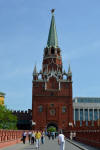 |
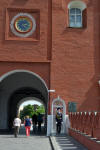 |
| ABOVE: Entering into what we once thought of as the heart of the enemy | |
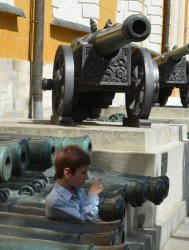
Once we had our tickets, we walked up the ramp from Alexander Gardens and entered the Kremlin through the Trinity Tower gate. Once inside, we were pleased to see that it wasn't too crowded at all if you avoided the tour groups, which we obviously tried to do as much as possible. We saw fortifications, government offices, gardens, palaces, river views and an impressive cluster of churches with gold onion domes.
The secular buildings included the Armoury Chamber, Arsenal, Senate, State Kremlin Palace, Terem Palace and Grand Kremlin Palace. The formal gardens were a particular delight, looking more like pictures of the Netherlands in springtime than anything that I would previously have associated with Russia.
Cathedral Square was another highlight, featuring three Russian Orthodox cathedrals and two historic churches. The cathedrals were dedicated to the Archangel Michael, the Annunciation and the Dormition of the Mother of God (a similar belief to the western Catholic doctrine of the Assumption), while of the smaller churches, one was named after the Twelve Apostles and the other after the legend of the Deposition of the Robe - the story that the Virgin Mary's robe was transported from Palestine to Constantinople. All five churches were absolutely spectacular internally, where it seemed that every square inch was covered with artwork. Photography was prohibited inside the buildings: staff were watching carefully and several people earned a well deserved rebuke for deciding that the rules couldn't possibly apply to them.
Altogether, I thought it was very pleasant walking around the Kremlin complex and dipping into the various attractions. A gentle breeze from the river made conditions more bearable than they had been before lunch.
 |
 |
 |
 |
 |
 |
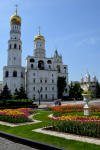 |
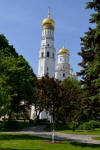 |
 |
 |
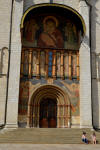 |
|
 |
 |
 |
|||
We had planned to ride the metro back to Tverskaya Street, but decided in the event that the distance was walkable, despite the heat and the final, uphill section.
Evening
After a chance to recover from the day's considerable exertions, we returned to the InterContinental's beautifully presented lobby bar for cocktails. Bruce managed to get an extra Martini on the house (along with profuse apologies) as a mistake had been made with the first one to be delivered. For dinner, we walked the short distance to Pushkin Square and a sushi restaurant that we had spotted on Sunday's introductory stroll. It had a rather trendy atmosphere, but the food was surprisingly good - all in all, an enjoyable end to a busy and fairly tiring day of intensive sightseeing.